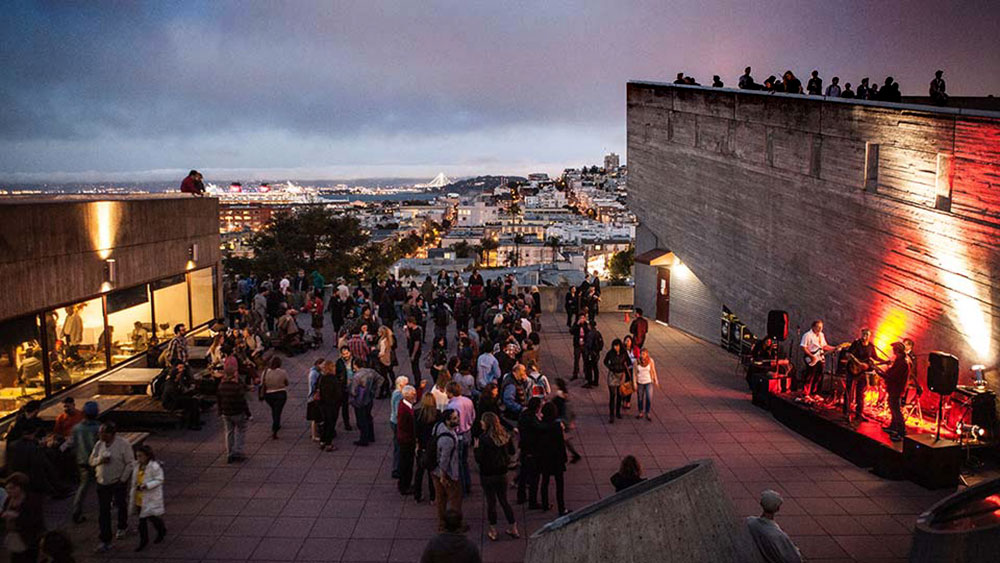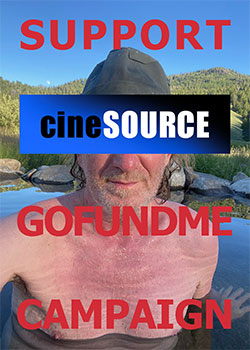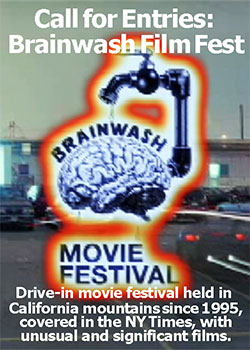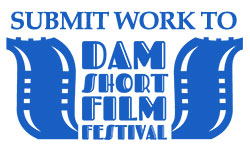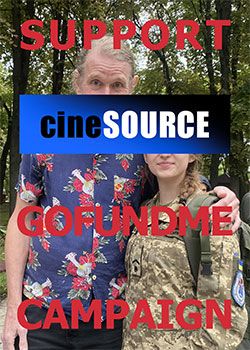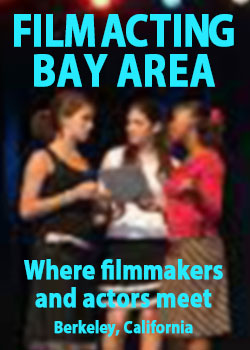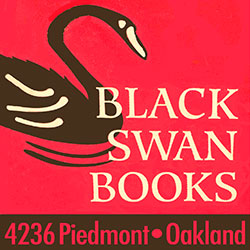SFAI: A Great Art School Goes Down
by Doniphan Blair
Please support our stories by liking articles—thanks!
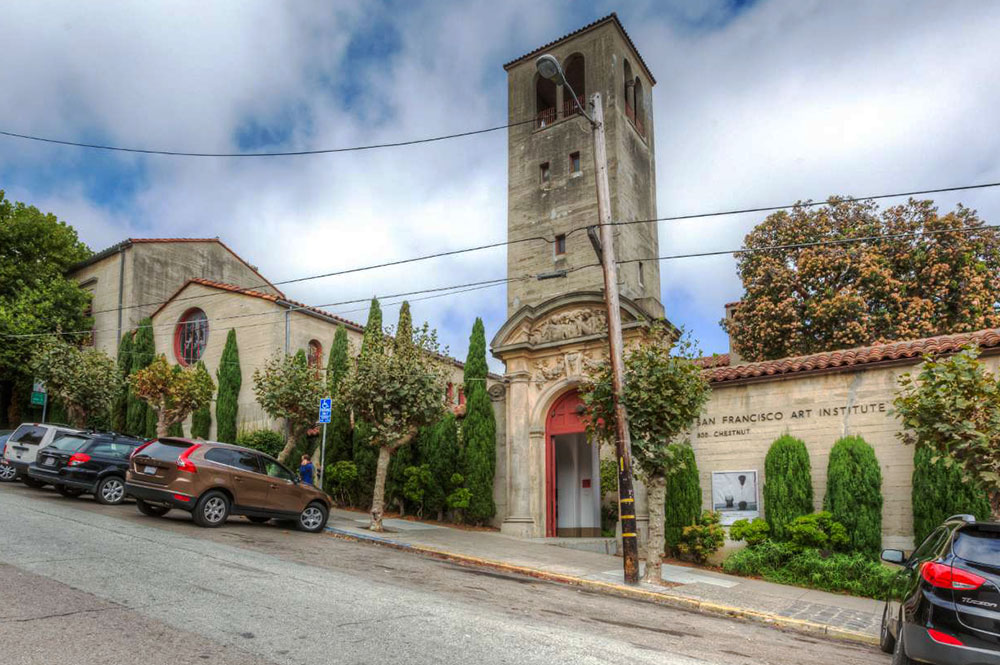 The steep hill, striking views and interesting gate welcomed all comers both to the San Francisco Art Institute's magnificent Moorish building and it’s ambitious art endeavors. photo: courtesy SFAIBREAKING NEWS 4/29: According to
The steep hill, striking views and interesting gate welcomed all comers both to the San Francisco Art Institute's magnificent Moorish building and it’s ambitious art endeavors. photo: courtesy SFAIBREAKING NEWS 4/29: According to
Artnet News: "The school will indeed suspend its degree programs after this spring, but rather than closing its doors for good, it will launch 'a campaign to reset and reinvent the school’s business model.'"
SADLY, ANOTHER ELDER HAS DIED FROM
the Covid-19 pandemic. This time it's San Francisco’s citadel of the arts, the Art Institute, which is giving up the ghost, just shy of its 150th birthday. Although it is a victim of Corona Collapse, we can't overlook the farrago of missteps and scandals, compounded by gentrification.
Founded in 1871 and one of America’s oldest art schools, SFAI was the first west of the Mississippi, the first devoted to contemporary art and the first with a photo department.
Indeed, the Institute was off the hook from 1973 to 1990, when I stretched a four-year BFA into 17 years of a fully-equipped, 24-hour access film studio, with a great café, gorgeous views and inspirational teachers, like filmmakers George Kuchar and Lawrence Jordan, among many others.
In my day, enrollment often exceeded 1000 students, including a large contingent of foreigners, attracted by the generous scholarships. More importantly was the dedication to a diversity of approaches, focusing on classical avant-garde, perhaps, but welcoming other views, as long as they were fresh, personal and dedicated.
By the fall semester of 2019, however, SFAI was down to under 400 undergraduates and 300 graduate students. This can also be attributed to San Francisco's art school or department boom, after it finally dawned on those schools' directors: "Who wouldn’t want to go to art school in San Francisco?"
Gordon Knox, SFAI’s director, “has his heart in the right place,” according to Jack Fulton, a photography professor and periodic department head for over four decades, who retired in 2014.
Knox endeavored to marry SFAI off to a larger institution, most promisingly the University of San Francisco, three miles away, which was an old Jesuit school but had begun adding art and film curriculum. Those negotiations came to naught, however, probably due to the price tag. In arrears for years, SFAI already owes $19 million.
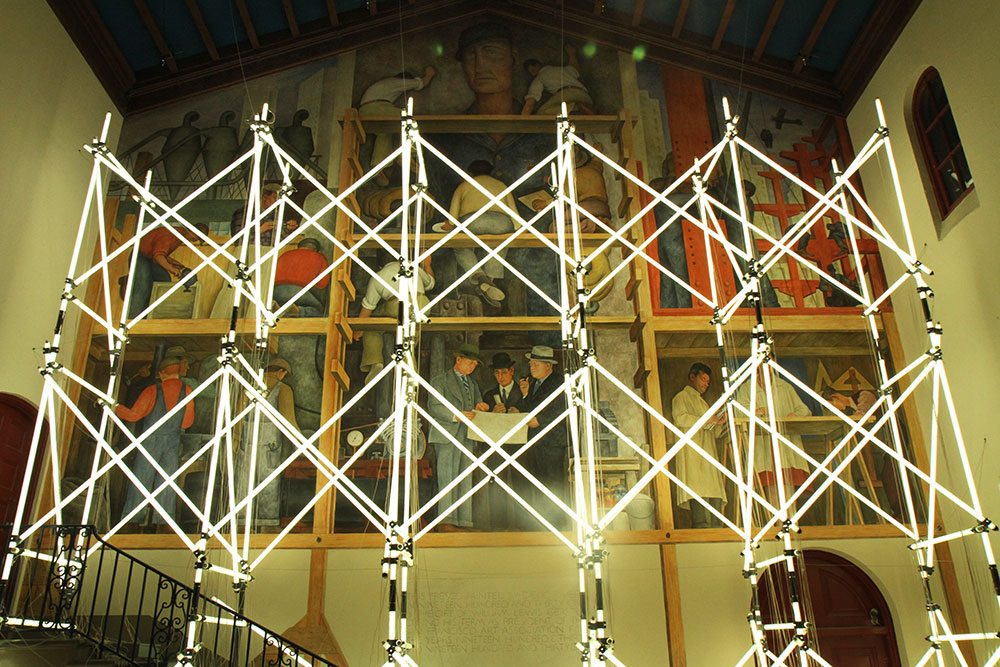 A neon sculpture, by a SFAI student, both mimics and masks the massive Diego Rivera mural looming over the school's student gallery. photo: D. BlairHence, the Institute will close its massive doors at the end of the spring semester, after their quarantined students complete their work, largely on line. The property will revert to University of California, which could make it their premier art school.
A neon sculpture, by a SFAI student, both mimics and masks the massive Diego Rivera mural looming over the school's student gallery. photo: D. BlairHence, the Institute will close its massive doors at the end of the spring semester, after their quarantined students complete their work, largely on line. The property will revert to University of California, which could make it their premier art school.
Famed for science more than art, however, the UC system will undoubtedly eye its assets, notably the magnificent Moorish monastery but also the 40-or-so-square-foot mural by Diego Rivera, painted in 1935, which has been appraised as high as $50 million (see cineSOURCE article).
Although the mural could be cut from the wall, to think that the monastery, with its arched courtyard, poi-filled fishpond and tower, as well as lovely mid-modern addition, would be demolished to build condos is enough to make you puke.
Even more nauseating is the notion that it could be snatched up by the Academy of Art, a more commercial art school which blew up in the last quarter century, but in the shadow of the Institute. With over 20 lessor properties around the City, the Academy directors would be overjoyed to add that feather to their cap.
“I have so many fond memories of it as a cultural hub,” Karl Cohen, the local animation expert and cineSOURCE contributor, told me. “I must have seen hundreds of film shows there. I provided light shows for parties [there] where the floor bounced up and down so much that I feared it might break.”
In addition to tuition being around $45,000, probably the primary problem facing SFAI was student housing, given even a small room fetches over $1,000 a month in the gentrified SF. In 1980, on the other hand, tuition was around $1600, while the neighborhood was full of 3-bedroom apartments for $300 or so, making it one of the most affordable private art schools in the country.
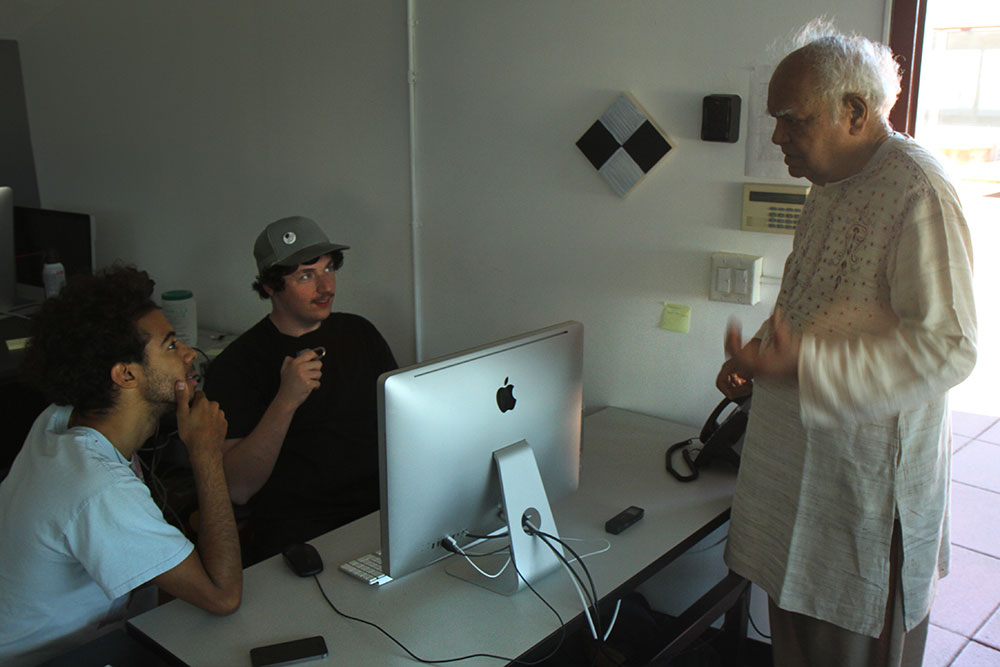 Om Prakash Sharma, director of the Delhi School of Art and famous Indian painter, took a special interest in SFAI's digital lab. photo: D. BlairThere were also a number of secondary problems, starting in the mid-‘90s with the school's failure to jump aboard digital, even though the silicon revolution was raging just 50 miles south.
Om Prakash Sharma, director of the Delhi School of Art and famous Indian painter, took a special interest in SFAI's digital lab. photo: D. BlairThere were also a number of secondary problems, starting in the mid-‘90s with the school's failure to jump aboard digital, even though the silicon revolution was raging just 50 miles south.
Then there was the colorful headmistress scandal. Ella Torrey King was a fascinating and larger-than-life talent, who ran the school from 1995 to 2003, but her story was a tragic one, given the rumors of embezzling, cocaine and romantic passion, as well as the well-documented suicide. The Art Institute authorities were also plagued by their quest to revive old glory, which they assumed was possible if they could only find and hire the art flavor of the month, rather than follow the school's more independent and iconoclast "artist of the west" tradition.
We are a long way from 1946, when freshly-furloughed soldiers flocked to the already-elderly institution, paid their tuition through the GI Bill and studied with fantastic painters like Mark Rothko, Clyfford Still and Ad Reinhardt—abstract expressionists now on view at any world-class museum—as well as locals like David Park and Elmer Bischoff.
The latter hailed from the Bay Area Figurative Movement, which rejected Abstract Expressionism and proved the school’s dedication to diversity. Emerging out of Oakland’s College of Arts and Crafts (now CCA), the Figuratives also included Wayne Thiebaud and Richard Diebenkorn.
More importantly perhaps, that same year, Ansel Adams, the world-famous landscape photographer, and Minor White started the school's photography department, which came to include the equally-outstanding Edward Weston, Dorothea Lange and Imogen Cunningham. Meanwhile Sydney Peterson did much the same for the film department.
Intoxicated at their vertiginous heights, they mounted an international conference in 1949, intended to spotlight flaws in modern art ideologies and attended by Frank Lloyd Wright and Marcel Duchamp.
Admittedly, the Institute’s ability to name drop soon dropped off, but there was still beaucoup talent. Annie Lebowitz, the great Rolling Stone Magazine photographer, was there in the late-60s, studying painting until she had her mind blown in a photography class. Ditto for Kathryn Bigelow but a film class, an epiphany that lead to her Oscar for directing “The Hurt Locker” (2008) as well as the much better “Near Dark” (1984).
Photography in 1970s was still stellar with teachers Jack Fulton, who found his art in nature, formal minimalist Hank Wessel (see article), regular minimalist Linda Connor and Pirkle Jones, who shot many of the iconic portraits of Oakland's Black Panthers.
The film department, for its part, became the envy of the nation with Jordan and Kuchar leading the way but also Gunvor Nelson, Al Wong and many guest appearances by Stan Brackhage and the two Bruces, Connor (see article) and Baillie (see article), three of the country’s top alt-filmmakers.
Even in the late ‘90s, it was doing quite well. The Nigerian-American Kehinde Wiley, who would go on to paint Barack and Michelle Obama’s portrait, took a BFA in 1999. Frazer Bradshaw, an Oakland film shooter and maker, famous for his little-known masterpiece “Everything Strange and New” (2008, see cineSOURCE article) told me, “I didn’t learn anything about technique at the Art Institute, but I did learn about art.” He was there for five years, as a student and staff member, starting in 1991.
“The 'po-mo' multiculturalism was a turning point in the ‘80s,” Fulton recalled. “They were less artists and more subscribers—subscribed to all that lingo of all the art schools: Yale, RISD, Chicago Art Institute.”
“I like art that challenged the norm,” Fulton continued. “I have always pushed the alternative, to see if people could stretch their minds. I think that is was what the po-mo people were trying to do. But I found that stuff by Derrida hard to read.”
I was also at SFAI in the ‘80s and noticed how the student body, so vibrant in the ‘70s, grew both cliquey and infatuated with Marxism, postmodernism and multiculturalism. That meant a lot of critiquing and canceling of work and artists but also fellow students, which turned the weekly class critique into a bloodbath.
In a 1989 class taught by James Broughton, a renown poet and filmmaker as well as a longtime SFAI fellow, it was inevitably him and me against the class. But it was still a wide open place, with any number of scenes, run by Steven Goldstein, a friendly, informal but brilliant fellow who came up managing SF's arts programs and was familiar with the community.
Then in 1995, through those Moorish gates strode Ella King Torrey. A dynamic, high flyer who graduated from Yale and collected African-American quilts, she came to SF from Philadelphia’s Pew Charitable Trusts. Evidently the board gave her carte blanche to atrial fibrillate the old institute and she tripled the endowment in a few years, but it came at a price.
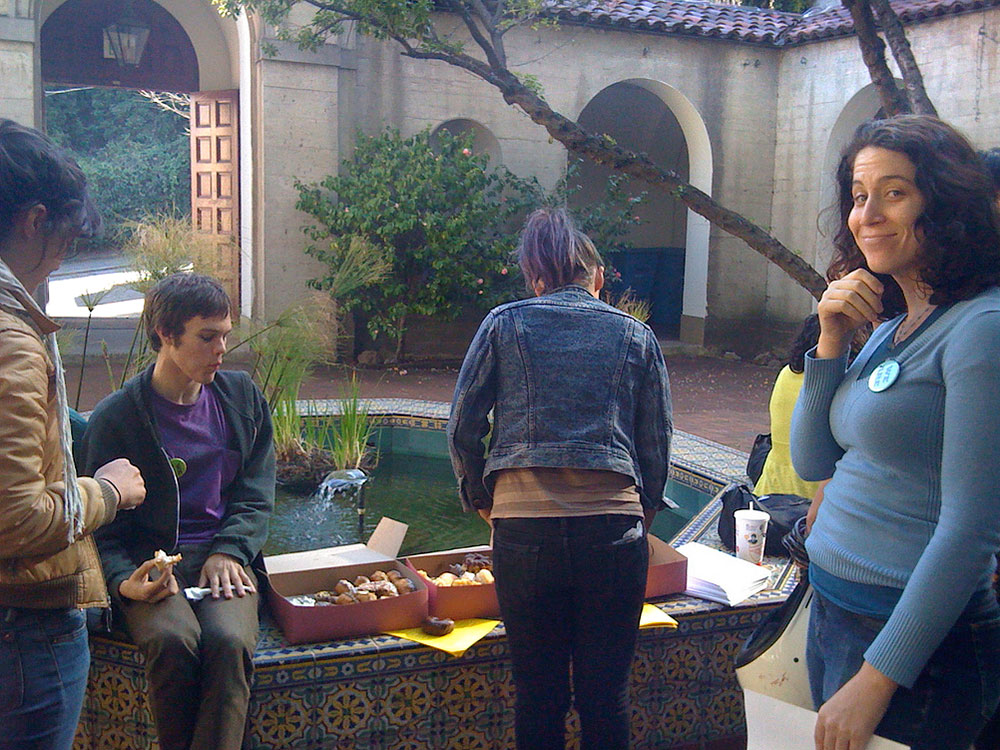 A morning class with coffee and donuts in SFAI's classic Moorish courtyard, replete with tiled fish pond. photo: unknownAlthough I've been trying to research what exactly happened for a decade, I am still not well known enough, after a decade publishing cineSOURCE, to get the powers that be to return my calls. Regardless, it's colorful and dramatic story, a cautionary tale of the complex doings of art school endeavors, perfect for a fascinating screenplay.
A morning class with coffee and donuts in SFAI's classic Moorish courtyard, replete with tiled fish pond. photo: unknownAlthough I've been trying to research what exactly happened for a decade, I am still not well known enough, after a decade publishing cineSOURCE, to get the powers that be to return my calls. Regardless, it's colorful and dramatic story, a cautionary tale of the complex doings of art school endeavors, perfect for a fascinating screenplay.
Perhaps Torrey was a fish out of Philadelphia who lost her bearing; perhaps she fell prey to ambition or greed. She was soon overspending, then even embezzling, up to a million dollars, developing a blow habit and falling in love with her chauffeur, who may not have been the best spirit guide.
“Ella King Torrey, I thought she was OK,” recalled Fulton. “As a women, she didn’t get all the respect she deserved. She had a lot of money, for a while, and she did get a space on [Fort Mason] to help the school grow. She brought in mural makers from the Mission and photography guys from theater and had them all out on the pier."
Fulton allowed, however, that setting up Torrey across the street from school in a $45 million mansion, owned by the head of the board, could have gone to anyone's head.
Bringing on “Ella King Torrey was the beginning of the end,” according to filmmaker Bradshaw.
“Her approach was out of sync with the institution. I don’t recall that she was embezzling, but she drove the institution to the brink by spending money that didn’t exist. When she arrived, there was suddenly money for all sorts of things that the staff had been begging to have upgraded for years.”
Bradshaw also couldn’t disagree more about not going digital.
"SFAI was a school of aesthetics. Until the introduction of the RED [digital camera] in 2007, there was no reasonably affordable motion acquisition tool that was aesthetic [decent quality]. And when they did go digital, they pretty much blew it, with cheap cameras that didn’t look good. Now all this could have been remedied with staff and faculty who were highly skilled, but they had none of that, and never really did, except for Roy Ramsing (one of my heroes).”
Sure SFAI could have remained the hold-out, dodo bird of the art school world, head in the sand of traditional tools—even with Adobe and Apple headquartered down the road—but that was not the SFAI I joined in 1973. Indeed, even though the faculty and admin were fully avant, the school had fantastic equipment: Éclair cameras, Nagra recorders, a 16-track mix studio.
Either way, it was a delicate balance. Ideas and image must come first. The west coast was not a Mecca for egghead critics and effete elites. Californians have traditionally lived in balance with its nature, as so spectacularly illustrated in the oeuvre of Jack Fulton, who was an avid hiker and whose father did some logging in the North-West.
“I’d like to see some SF scrillionaires scrape up 30 million to save it as cultural institution,” Fulton concluded. “Certainly, every one would talk about it and give donations.”
Indeed, Salesforce Tower, the uninspired 1000-foot skyscraper now towering over downtown San Francisco cost $1.1 billion in 2018. For two percent of that, someone could revive a century-and-half old art scene as well as school, one which just might guide not only San Francisco but Silicon Valley through what may prove to be an aesthetically-trying 21st century.
Some older cineSOURCE articles on SFAI:
SFAI Still Struggling Over Fired Faculty,
Film Fades at SFAI
Roll Camera, Action, SFAI Film!
Doniphan Blair is a writer, film magazine publisher, designer, musician and filmmaker ('Our Holocaust Vacation'), who can be reached Posted on Apr 05, 2020 - 12:33 AM
by Doniphan Blair
Please support our stories by liking articles—thanks!
 The steep hill, striking views and interesting gate welcomed all comers both to the San Francisco Art Institute's magnificent Moorish building and it’s ambitious art endeavors. photo: courtesy SFAI
The steep hill, striking views and interesting gate welcomed all comers both to the San Francisco Art Institute's magnificent Moorish building and it’s ambitious art endeavors. photo: courtesy SFAIArtnet News: "The school will indeed suspend its degree programs after this spring, but rather than closing its doors for good, it will launch 'a campaign to reset and reinvent the school’s business model.'"
SADLY, ANOTHER ELDER HAS DIED FROM
the Covid-19 pandemic. This time it's San Francisco’s citadel of the arts, the Art Institute, which is giving up the ghost, just shy of its 150th birthday. Although it is a victim of Corona Collapse, we can't overlook the farrago of missteps and scandals, compounded by gentrification.
Founded in 1871 and one of America’s oldest art schools, SFAI was the first west of the Mississippi, the first devoted to contemporary art and the first with a photo department.
Indeed, the Institute was off the hook from 1973 to 1990, when I stretched a four-year BFA into 17 years of a fully-equipped, 24-hour access film studio, with a great café, gorgeous views and inspirational teachers, like filmmakers George Kuchar and Lawrence Jordan, among many others.
In my day, enrollment often exceeded 1000 students, including a large contingent of foreigners, attracted by the generous scholarships. More importantly was the dedication to a diversity of approaches, focusing on classical avant-garde, perhaps, but welcoming other views, as long as they were fresh, personal and dedicated.
By the fall semester of 2019, however, SFAI was down to under 400 undergraduates and 300 graduate students. This can also be attributed to San Francisco's art school or department boom, after it finally dawned on those schools' directors: "Who wouldn’t want to go to art school in San Francisco?"
Gordon Knox, SFAI’s director, “has his heart in the right place,” according to Jack Fulton, a photography professor and periodic department head for over four decades, who retired in 2014.
Knox endeavored to marry SFAI off to a larger institution, most promisingly the University of San Francisco, three miles away, which was an old Jesuit school but had begun adding art and film curriculum. Those negotiations came to naught, however, probably due to the price tag. In arrears for years, SFAI already owes $19 million.
 A neon sculpture, by a SFAI student, both mimics and masks the massive Diego Rivera mural looming over the school's student gallery. photo: D. Blair
A neon sculpture, by a SFAI student, both mimics and masks the massive Diego Rivera mural looming over the school's student gallery. photo: D. BlairFamed for science more than art, however, the UC system will undoubtedly eye its assets, notably the magnificent Moorish monastery but also the 40-or-so-square-foot mural by Diego Rivera, painted in 1935, which has been appraised as high as $50 million (see cineSOURCE article).
Although the mural could be cut from the wall, to think that the monastery, with its arched courtyard, poi-filled fishpond and tower, as well as lovely mid-modern addition, would be demolished to build condos is enough to make you puke.
Even more nauseating is the notion that it could be snatched up by the Academy of Art, a more commercial art school which blew up in the last quarter century, but in the shadow of the Institute. With over 20 lessor properties around the City, the Academy directors would be overjoyed to add that feather to their cap.
“I have so many fond memories of it as a cultural hub,” Karl Cohen, the local animation expert and cineSOURCE contributor, told me. “I must have seen hundreds of film shows there. I provided light shows for parties [there] where the floor bounced up and down so much that I feared it might break.”
In addition to tuition being around $45,000, probably the primary problem facing SFAI was student housing, given even a small room fetches over $1,000 a month in the gentrified SF. In 1980, on the other hand, tuition was around $1600, while the neighborhood was full of 3-bedroom apartments for $300 or so, making it one of the most affordable private art schools in the country.
 Om Prakash Sharma, director of the Delhi School of Art and famous Indian painter, took a special interest in SFAI's digital lab. photo: D. Blair
Om Prakash Sharma, director of the Delhi School of Art and famous Indian painter, took a special interest in SFAI's digital lab. photo: D. BlairThen there was the colorful headmistress scandal. Ella Torrey King was a fascinating and larger-than-life talent, who ran the school from 1995 to 2003, but her story was a tragic one, given the rumors of embezzling, cocaine and romantic passion, as well as the well-documented suicide. The Art Institute authorities were also plagued by their quest to revive old glory, which they assumed was possible if they could only find and hire the art flavor of the month, rather than follow the school's more independent and iconoclast "artist of the west" tradition.
We are a long way from 1946, when freshly-furloughed soldiers flocked to the already-elderly institution, paid their tuition through the GI Bill and studied with fantastic painters like Mark Rothko, Clyfford Still and Ad Reinhardt—abstract expressionists now on view at any world-class museum—as well as locals like David Park and Elmer Bischoff.
The latter hailed from the Bay Area Figurative Movement, which rejected Abstract Expressionism and proved the school’s dedication to diversity. Emerging out of Oakland’s College of Arts and Crafts (now CCA), the Figuratives also included Wayne Thiebaud and Richard Diebenkorn.
More importantly perhaps, that same year, Ansel Adams, the world-famous landscape photographer, and Minor White started the school's photography department, which came to include the equally-outstanding Edward Weston, Dorothea Lange and Imogen Cunningham. Meanwhile Sydney Peterson did much the same for the film department.
Intoxicated at their vertiginous heights, they mounted an international conference in 1949, intended to spotlight flaws in modern art ideologies and attended by Frank Lloyd Wright and Marcel Duchamp.
Admittedly, the Institute’s ability to name drop soon dropped off, but there was still beaucoup talent. Annie Lebowitz, the great Rolling Stone Magazine photographer, was there in the late-60s, studying painting until she had her mind blown in a photography class. Ditto for Kathryn Bigelow but a film class, an epiphany that lead to her Oscar for directing “The Hurt Locker” (2008) as well as the much better “Near Dark” (1984).
Photography in 1970s was still stellar with teachers Jack Fulton, who found his art in nature, formal minimalist Hank Wessel (see article), regular minimalist Linda Connor and Pirkle Jones, who shot many of the iconic portraits of Oakland's Black Panthers.
The film department, for its part, became the envy of the nation with Jordan and Kuchar leading the way but also Gunvor Nelson, Al Wong and many guest appearances by Stan Brackhage and the two Bruces, Connor (see article) and Baillie (see article), three of the country’s top alt-filmmakers.
Even in the late ‘90s, it was doing quite well. The Nigerian-American Kehinde Wiley, who would go on to paint Barack and Michelle Obama’s portrait, took a BFA in 1999. Frazer Bradshaw, an Oakland film shooter and maker, famous for his little-known masterpiece “Everything Strange and New” (2008, see cineSOURCE article) told me, “I didn’t learn anything about technique at the Art Institute, but I did learn about art.” He was there for five years, as a student and staff member, starting in 1991.
“The 'po-mo' multiculturalism was a turning point in the ‘80s,” Fulton recalled. “They were less artists and more subscribers—subscribed to all that lingo of all the art schools: Yale, RISD, Chicago Art Institute.”
“I like art that challenged the norm,” Fulton continued. “I have always pushed the alternative, to see if people could stretch their minds. I think that is was what the po-mo people were trying to do. But I found that stuff by Derrida hard to read.”
I was also at SFAI in the ‘80s and noticed how the student body, so vibrant in the ‘70s, grew both cliquey and infatuated with Marxism, postmodernism and multiculturalism. That meant a lot of critiquing and canceling of work and artists but also fellow students, which turned the weekly class critique into a bloodbath.
In a 1989 class taught by James Broughton, a renown poet and filmmaker as well as a longtime SFAI fellow, it was inevitably him and me against the class. But it was still a wide open place, with any number of scenes, run by Steven Goldstein, a friendly, informal but brilliant fellow who came up managing SF's arts programs and was familiar with the community.
Then in 1995, through those Moorish gates strode Ella King Torrey. A dynamic, high flyer who graduated from Yale and collected African-American quilts, she came to SF from Philadelphia’s Pew Charitable Trusts. Evidently the board gave her carte blanche to atrial fibrillate the old institute and she tripled the endowment in a few years, but it came at a price.
 A morning class with coffee and donuts in SFAI's classic Moorish courtyard, replete with tiled fish pond. photo: unknown
A morning class with coffee and donuts in SFAI's classic Moorish courtyard, replete with tiled fish pond. photo: unknownPerhaps Torrey was a fish out of Philadelphia who lost her bearing; perhaps she fell prey to ambition or greed. She was soon overspending, then even embezzling, up to a million dollars, developing a blow habit and falling in love with her chauffeur, who may not have been the best spirit guide.
“Ella King Torrey, I thought she was OK,” recalled Fulton. “As a women, she didn’t get all the respect she deserved. She had a lot of money, for a while, and she did get a space on [Fort Mason] to help the school grow. She brought in mural makers from the Mission and photography guys from theater and had them all out on the pier."
Fulton allowed, however, that setting up Torrey across the street from school in a $45 million mansion, owned by the head of the board, could have gone to anyone's head.
Bringing on “Ella King Torrey was the beginning of the end,” according to filmmaker Bradshaw.
“Her approach was out of sync with the institution. I don’t recall that she was embezzling, but she drove the institution to the brink by spending money that didn’t exist. When she arrived, there was suddenly money for all sorts of things that the staff had been begging to have upgraded for years.”
Bradshaw also couldn’t disagree more about not going digital.
"SFAI was a school of aesthetics. Until the introduction of the RED [digital camera] in 2007, there was no reasonably affordable motion acquisition tool that was aesthetic [decent quality]. And when they did go digital, they pretty much blew it, with cheap cameras that didn’t look good. Now all this could have been remedied with staff and faculty who were highly skilled, but they had none of that, and never really did, except for Roy Ramsing (one of my heroes).”
Sure SFAI could have remained the hold-out, dodo bird of the art school world, head in the sand of traditional tools—even with Adobe and Apple headquartered down the road—but that was not the SFAI I joined in 1973. Indeed, even though the faculty and admin were fully avant, the school had fantastic equipment: Éclair cameras, Nagra recorders, a 16-track mix studio.
Either way, it was a delicate balance. Ideas and image must come first. The west coast was not a Mecca for egghead critics and effete elites. Californians have traditionally lived in balance with its nature, as so spectacularly illustrated in the oeuvre of Jack Fulton, who was an avid hiker and whose father did some logging in the North-West.
“I’d like to see some SF scrillionaires scrape up 30 million to save it as cultural institution,” Fulton concluded. “Certainly, every one would talk about it and give donations.”
Indeed, Salesforce Tower, the uninspired 1000-foot skyscraper now towering over downtown San Francisco cost $1.1 billion in 2018. For two percent of that, someone could revive a century-and-half old art scene as well as school, one which just might guide not only San Francisco but Silicon Valley through what may prove to be an aesthetically-trying 21st century.
Some older cineSOURCE articles on SFAI:
SFAI Still Struggling Over Fired Faculty,
Film Fades at SFAI
Roll Camera, Action, SFAI Film!
Doniphan Blair is a writer, film magazine publisher, designer, musician and filmmaker ('Our Holocaust Vacation'), who can be reached Posted on Apr 05, 2020 - 12:33 AM















